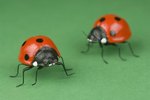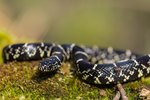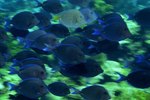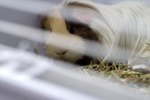
When you think of the word "pet," you might instantly imagine something soft and fluffy, whether a dog, cat or hamster. While bearded dragons (genus Pogona) are indeed often mild-mannered pet lizards, neither of those adjectives come close to describing them. Bearded dragons' bodies are topped with many spikes, after all.
Spikes and Scales
Bearded dragons' physiques look rather rough, what with all of the spines that appear all over them. Not only are these Australian lizards covered in spikes, they're also covered in small and uneven scales that further contribute to their somewhat rugged appearances. Their spikes exist on the edges of their physiques, on their heads and even on their throats.
Purpose of the Spikes
Bearded dragons' many angular spikes and scales don't exist without a purpose. They help protect the lizards from their enemies. Predators of bearded dragons out in nature include various big lizards and dingoes (Canis lupus dingo), among others. These mostly independent lizards' spikes and scales appear painful to the touch, and therefore often successfully dissuade would-be predators.
Defensive Show
When bearded dragons are fearful and intimidated, they frequently use their spikes in defensive displays. Their throat pouches feature an abundance of spikes that make up the "beards" of their naming. When bearded dragons feel at risk, they expand these pouches conspicuously. By doing this, bearded dragons craftily make themselves appear significantly larger -- and more menacing -- than they are in actuality. Their sudden size increase is sometimes all it takes to get their predators to flee. Captive bearded dragons that are secure around their human caretakers and surroundings often cease showing off their famous beards. Male specimens tend to have more prominent beards than females. Their heads also usually are bigger than those of females.
Other Physical Appearance Details
If you're looking to identify a bearded dragon just by his appearance, knowledge beyond the spikes and scales on his body are a must. Bearded dragons appear in a handful of different colors. Some specimens are yellow, while others are beige, reddish-orange, gray or lackluster brown. Specialized captive breeding has brought upon a wide array of colors in the bearded dragon universe. Bearded dragons possess extremely lengthy tails that are not much shorter than their full bodies. Their heads are somewhat triangular in form, too.
References
- Animal Planet: Bearded Dragon - Stats & Facts
- The Bearded Dragon; Jake Miller
- Meet the Bearded Dragon; Suzanne Buckingham
- Bearded Dragons; Jason Glaser
- SQL Cookbook; Anthony Molinaro
- Bearded Dragon - Your Happy Healthy Pet; Steve Grenard
- Royal Society for the Prevention of Cruelty to Animals: Bearded Dragon
- Long Island Herpetological Society: Bearded Dragon
- Bearded Dragons; R.D. Bartlett and Patricia P. Bartlett
- Desert; Miranda Macquitty
Resources
Photo Credits
-
BananaStock/BananaStock/Getty Images




